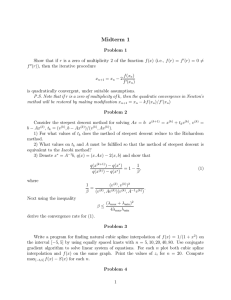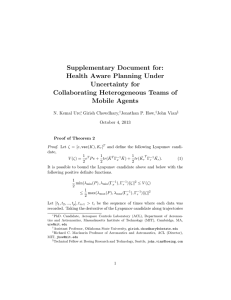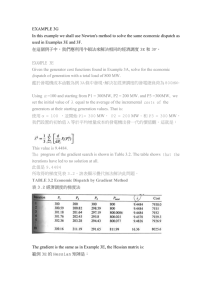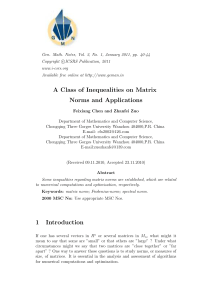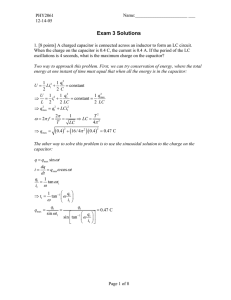A Globally and Quadratically Convergent Algorithm with Efficient
advertisement
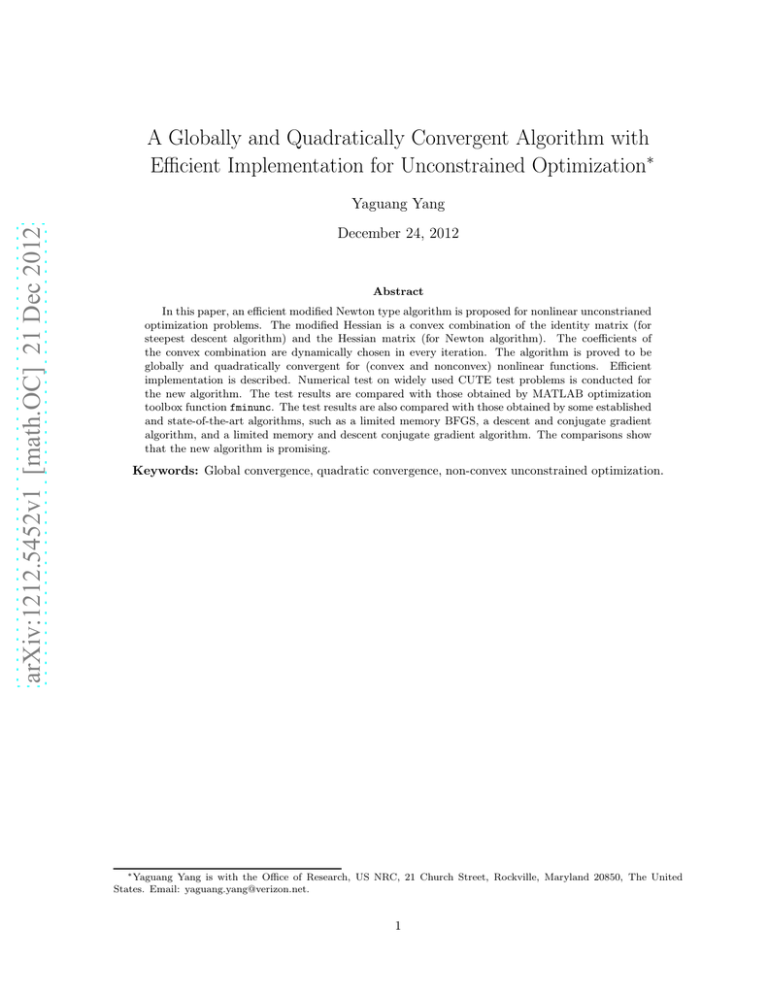
A Globally and Quadratically Convergent Algorithm with
Efficient Implementation for Unconstrained Optimization∗
arXiv:1212.5452v1 [math.OC] 21 Dec 2012
Yaguang Yang
December 24, 2012
Abstract
In this paper, an efficient modified Newton type algorithm is proposed for nonlinear unconstrianed
optimization problems. The modified Hessian is a convex combination of the identity matrix (for
steepest descent algorithm) and the Hessian matrix (for Newton algorithm). The coefficients of
the convex combination are dynamically chosen in every iteration. The algorithm is proved to be
globally and quadratically convergent for (convex and nonconvex) nonlinear functions. Efficient
implementation is described. Numerical test on widely used CUTE test problems is conducted for
the new algorithm. The test results are compared with those obtained by MATLAB optimization
toolbox function fminunc. The test results are also compared with those obtained by some established
and state-of-the-art algorithms, such as a limited memory BFGS, a descent and conjugate gradient
algorithm, and a limited memory and descent conjugate gradient algorithm. The comparisons show
that the new algorithm is promising.
Keywords: Global convergence, quadratic convergence, non-convex unconstrained optimization.
∗ Yaguang Yang is with the Office of Research, US NRC, 21 Church Street, Rockville, Maryland 20850, The United
States. Email: yaguang.yang@verizon.net.
1
1
Introduction
Newton type algorithm is attractive due to its fast convergence rate [2]. In non-convex case, Newton
algorithm may not be globally convergent, therefore, various modified Newton algorithms have been
proposed, for example [9] [10]. The idea is to add a positive diagonal matrix to the Hessian matrix so
that the modified Hessian is positive definite and the modified algorithms become globally convergent,
which is similar to the idea of Levenberg-Marquardt method studied in [22]. However, for the iterates
far away from the solution set, the added diagonal matrix may be very large. This may lead to the
poor condition number of the modified Hessian, generate a very small step, and prevent the iterates from
quickly moving to the solution set [7].
In this paper, we propose a slightly different modified Newton algorithm. The modified Hessian is a
convex combination of the Hessian (for Newton algorithm) and the identity matrix (for steepest descent
algorithm). Therefore, the condition number of the modified Hessian is well controlled, and the steepest
descent algorithm and Newton algorithm are special cases of the proposed algorithm. We will show that
the proposed algorithm has merits of both the steepest descent algorithm and the Newton algorithm,
i.e., the algorithm is globally and quadratically convergent. We will also show that the algorithm can be
implemented in an efficient way, using the optimization techniques on Riemannian manifolds proposed in
[5], [18], [23], and [24]. Numerical test for the new algorithm is conducted for the widely used nonlinear
optimization test problem set CUTE downloaded from [1]. The test results are compared with those
obtained by MATLAB optimization toolbox function fminunc. The test results are also compared with
those obtained by some established and state-of-the-art algorithms, such as limited memory BFGS [17],
a descent and conjugate gradient algorithm [14], and a limited memory and descent conjugate gradient
algorithm [13]. The comparison shows that the new algorithm is promising.
The rest paper is organized as follows. Section 2 proposes the modified Newton algorithm and provides
the convergence results. Section 3 discusses an efficient implementation involving calculations of the
maximum and minimum eigenvalues of the modified Hessian matrix. Section 4 presents numerical test
results. The last section summarizes the main result of this paper.
2
Modified Newton Method
Our objective is to minimize a multi-variable nonlinear (convex or non-convex) function
min f (x),
(1)
where f is twice differentiable. Throughout the paper, we define by g(x) or simply by g the gradient
of f (x), by H(x) or simply by H the Hessian of f (x), by λmax H(x) or simply λmax (H) the maximum
eigenvalue of H(x), by λmin H(x) or simply λmin (H) the minimum eigenvalue of H(x). Assuming that x̄
is a local minimizer, we make the following assumptions in our convergence analysis.
Assumptions:
1. g(x̄) = 0.
2. The gradient g(x) is Lipschitz continuous, i.e., there exists a constant L > 0 such that for any x
and y,
kg(x) − g(y)k ≤ Lkx − yk.
(2)
3. There are small positive numbers δ > 0, η > 0, and a large positive number ∆ ≥ 1, and a
neighborhood of x̄, defined by N (x̄) = {x : kg(x) − g(x̄)k ≤ η}, such that for all x ∈ N (x̄),
λmin (H(x)) ≥ δ > 0 and λmax (H)/λmin (H) ≤ ∆.
Assumptions 1 is standard, i.e., x̄ meets the first order necessary condition. If the gradient is Lipschitz
continuous as defined in Assumption 2, then N (x̄) is well defined. Assumption 3 indicates that for
all x ∈ N (x̄), a strong second order sufficient condition holds, and the condition number of Hessian is
bounded which is equivalent to λmax (H) < ∞ given λmin (H(x)) ≥ δ.
2
In the remaining discussion, we will use subscript k for the kth iteration. The idea of the proposed
algorithm is to search optimizers along a direction dk that satisfies
(γk I + (1 − γk )H(xk ))dk = Bk dk = −g(xk ),
(3)
where γk ∈ [0, 1] will be carefully selected in every iteration. Clearly, the modified Hessian is a convex combination of the identity matrix for steepest descent algorithm and the Hessian for the Newton
algorithm. When γk = 1, the algorithm reduces to the steepest descent algorithm; when γk = 0, the
algorithm reduces to the Newton algorithm. We will focus on the selection of γk , and we will prove the
global and quadratic convergence of the proposed algorithm. The convergence properties are directly
related to the goodness of the search direction and step length, which in turn decide the selection criteria
of γk . The quality of the search direction is measured by
cos(θk ) = −
gkT dk
,
kgk kkdk k
(4)
which should be bounded below from zero in all iterations. A good step length αk should satisfy the
following Wolfe condition.
f (xk + αk dk ) ≤ f (xk ) + σ1 αk gkT dk ,
g(xk + αk dk ) ≥
σ2 gkT dk ,
(5a)
(5b)
where 0 < σ1 < σ2 < 1. The existence of Wolfe condition is established in [20, 21]. The proposed
algorithm is given as follows.
Algorithm 2.1 Modified Newton
Data: 0 < δ, and 1 ≤ ∆ < ∞, initial x0 .
for k=0,1,2,...
Calculate gradient g(xk ).
Calculate Hessian H(xk ), select γk , and calculate dk from (3).
Select αk and set xk+1 = xk + αk dk .
end
Remark 2.1 An algorithm that finds, in finite steps, a point satisfying Wolfe condition is given in [16].
Therefore, the selection of αk will not be discussed in this paper.
We will use an important global convergence result given by Zoutendijk [25] which can be stated as
follows.
Theorem 2.1 Suppose that f is bounded below in Rn and that f is continuously twice differentiable in a
neighborhood M of the level set L = {x : f (x) ≤ f (x0 )}. Assume that the gradient is Lipschitz continuous
for all x, y ∈ M. Assume further that dk is a descent direction and αk satisfies the Wolfe condition.
Then
X
cos2 (θk )kgk k2 < ∞.
(6)
k≥0
Zoutendijk theorem indicates that if for all k ≥ 0, dk is a descent direction; and for a constant C,
cos(θk ) ≥ C > 0, then the algorithm is globally convergent because limk→∞ kgk k = 0. To assure that dk
is a descent direction, Bk should be strictly positive. This can be achieved by setting
γk + (1 − γk )λmin (Hk ) ≥ δ,
3
(7)
which is equivalent to
γk (1 − λmin (Hk )) ≥ δ − λmin (Hk ).
Therefore, we set
γk =
(
δ−λmin (Hk )
1−λmin (Hk )
if λmin (Hk ) < δ
if λmin (Hk ) ≥ δ.
0
(8)
(9)
In view of (3) and (4), it is clear that if
kBk kkBk−1 k ≤ ∆,
(10)
where 1 ≤ ∆ < ∞, then cos(θk ) ≥ 1/∆ = C > 0. Therefore, in view of Theorem 2.1, to achieve the
global convergence, from (3) and (10), ∆ should meet the following condition
γk + (1 − γk )λmax (Hk )
≤ ∆.
γk + (1 − γk )λmin (Hk )
(11)
Using (7) and γk + (1 − γk )λmin (Hk ) > 0, we have
(∆ − 1 + λmax (Hk ) − λmin (Hk )∆)γk ≥ λmax (Hk ) − λmin (Hk )∆.
Since ∆ − 1 + λmax (Hk ) − λmin (Hk )∆ ≥ λmax (Hk ) − λmin (Hk )∆, we should select
(
0
if λmax (Hk ) ≤ λmin (Hk )∆
γk =
λmax (Hk )−λmin (Hk )∆
if λmax (Hk ) > λmin (Hk )∆.
∆−1+λmax (Hk )−λmin (Hk )∆
Combining (9) and (13) yields
0
a = δ−λmin(Hk )
k
1−λmin(Hk )
γk =
λmax (Hk )−λmin (Hk )∆
b
=
∆−1+λmax (Hk )−λmin (Hk )∆
k
max{ak , bk }
if λmin (Hk ) ≥ δ and λmax (Hk ) ≤ λmin (Hk )∆
if λmin (Hk ) < δ and λmax (Hk ) ≤ λmin (Hk )∆
if λmin (Hk ) ≥ δ and λmax (Hk ) > λmin (Hk )∆
else
(12)
(13)
(14)
It is clear to see from the selection of γk that (8) and (12) hold. This means that the conditions of
Theorem 2.1 hold. Therefore, Algorithm 2.1 is globally convergent.
Since Algorithm 2.1 is globally convergent in the sense that limk→∞ kgk k = 0, there exists an
η > 0 such that for k large enough, kg(xk )k ≤ η; from Assumption 3, λmin (H(xk )) ≥ δ > 0 and
λmax (Hk )/λmin (Hk ) ≤ ∆. From (14), γk = 0 for all k large enough, i.e., Algorithm 2.1 reduces to
Newton algorithm. Therefore, the proposed algorithm is quadratic convergent. We summarize the main
result of this paper as the following
Theorem 2.2 Suppose that f is bounded below in Rn and that f is continuously twice differentiable in a
neighborhood M of the level set L = {x : f (x) ≤ f (x0 )}. Assume that the gradient is Lipschitz continuous
for all x, y ∈ M. Assume further that dk is defined as in (3) with γk being selected as in (14) and αk
satisfies the Wolfe condition. Then Algorithm 2.1 is globally convergent. Moreover, if the convergent
point x̄ satisfies Assumption 3, then Algorithm 2.1 converges to x̄ in quadratic rate.
Remark 2.2 Since Bk is positive definite, Cholesky factorization exist, (3) can be solved efficiently.
Furthermore, if Hk is sparse, (3) can be solved using techniques for a sparse matrix.
3
Implementation Consideration
To implement Algorithm 2.1 for practical use, we need to consider several issues.
3.1
Termination
First, we need to have a termination rule in Algorithm 2.1. This rule is checked at the end of Step 1. For
0 < ǫ, if kg(xk )k < ǫ or kg(xk )k∞ < ǫ, stop.
4
3.2
Computation of extreme eigenvalues
The most significant computation in the proposed algorithm is the selection of γk , which involves the
computation of λmax (Hk ) and λmin (Hk ) for the symmetric matrix H. There are general algorithms to
compute eigenvalues and eigenvectors for a symmetric matrix [11]. However, there are much more efficient
algorithms for extreme eigenvalues for a symmetric matrix, which is equivalent to find the solution of
Rayleigh Quotient
xT Hk x
λmax (Hk ) = max xT Hk x = max
,
(15)
xT x
kxk=1
λmin (Hk ) = min xT Hk x = min
kxk=1
xT Hk x
.
xT x
(16)
It is well-known that there are cubically convergent algorithms to find the solution of Rayleigh Quotient
[5]. In our opinion, the most efficient methods are the conjugate gradient optimization algorithm on
Riemannian manifold proposed by Smith [18], and the Armijo-Newton optimization algorithm on Riemannian manifold proposed by Yang [23] [24]. Both methods make fully use of the geometry of the
unit sphere (kxk = 1) and search the solution along the arc defined by geodesics over the unit sphere.
Armijo-Newton algorithm may converge faster, but it may converge to an internal eigenvalue rather than
an extreme eigenvalue. Conjugate gradient optimization algorithm may also converge to an internal
eigenvalue, but the chance is much smaller and a small perturbation may lead the iterate to converge
to the desired extreme eigenvalues. Let x be on unit sphere and ρ(x) = xT Hx. For vector v in tangent
space at x, τ v denote parallelism of v along the geodesic defined by a unit length vector q in tangent
space at x, it is shown in [18]
τ v = v − (v T q)(x sin(t) + q(1 − cos(t)).
(17)
To find the maximum eigenvalue of H defined in (15), the conjugate gradient algorithm proposed in [18]
is stated as follows (with very minor but important modification presented in bold font).
Algorithm 3.1 Conjugate gradient (CG) for maximum eigenvalue
Data: 0 < ǫ, initial x0 with kx0 k = 1, G0 = Q0 = (H − ρ(x0 )I)x0 .
for k=0,1,2,...
Qk
.
Calculate c, s, and v = 1 − c, such that ρ(xk c + qk s) is maximized, where c2 + s2 = 1, qk = kQ
kk
This can be accomplished by geodesic maximization and the formula is given by
q
c = 1 1 + b , s = a , if b ≥ 0
r
2rc
q2
(18)
s = 1 1 − b , c = a , if b ≤ 0
2
r
T
T
where a = 2xT
k Hqk , b = xk Hxk − qk Hqk , and r =
Set xk+1 = xk c + qk s, xk+1 =
xk+1
kxk+1 k ,
2rs
√
a2 + b 2 .
τ Qk = Qk c − xk kQk ks, and τ Gk = Gk − (qkT Gk )(xk s + qk v).
Set Gk+1 = (H − ρ(xk+1 )I)xk+1 , Qk+1 = Gk+1 + µk τ Qk , where µk =
(Gk+1 −τ Gk )T Gk+1
.
GT
k Qk
Set Qk+1 = (I − xk+1 xT
k+1 )Qk+1 .
If k ≡ n − 1, set Qk+1 = (I − xk+1 xT
k+1 )Gk+1 .
end
Remark 3.1 Qk+1 should be on tangent space at xk+1 . But numerical error may change Qk+1 slightly.
Therefore, the projection is necessary to bring Qk+1 back to the tangent space at xk+1 . Similar changes
are made to ensure the unit length of xk . With these minor changes, the CG algorithm is much more
stable and the observed convergence rate is faster than the one reported in [18].
5
Remark 3.2 To search for the minimum eigenvalue of (16), (18) is replaced by
q
c = 1 1 − b , s = a , if b ≥ 0
r
2rc
q2
s = 1 1 + b , c = a , if b ≤ 0
2
r
2rs
(19)
which is obtained by minimizing ρ(xk c + qk s) under the constraint c2 + s2 = 1.
Remark 3.3 Each iteration of Algorithm 3.1 involves only matrix and vector multiplications, the cost
O(n2 ) is very low. Our experience shows that it needs only a few iterations to converge to the extreme
eigenvalues.
Remark 3.4 If H is sparse, Algorithm 3.1 will be very efficient.
3.3
The implemented modified Newton algorithm
The implemented modified Newton algorithm is as follows.
Algorithm 3.2 Modified Newton
Data: 0 < δ, 0 < ǫ, and 1 ≤ ∆ < ∞, initial x0 with kx0 k = 1.
for k=1,2,...
Calculate gradient g(xk ).
If kg(xk )k < ǫ or kg(xk )k∞ < ǫ, stop.
Calculate Hessian H(xk ).
Calculate λmax (Hk ) and λmin (Hk ) using Algorithm 3.1.
Select γk using (14), and calculate dk using (3).
If dk is not a descent direction, Algorithm 3.1 generates an internal eigevalue. A conventional
method will be used to find λmax (Hk ) and λmin (Hk ). Then, select γk using (14), and calculate dk
using (3).
Select αk using one dimensional search and set xk+1 = xk + αk dk .
end
Remark 3.5 It is very rare to use a conventional method to calculate λmax (Hk ) and λmin (Hk ). But this
safeguard is needed in case that Algorithm 3.1 generates an internal eigevalue.
4
Numerical Test
In this section, we present some test results for both Algorithm 3.1 and Algorithm 3.2.
4.1
Test of Algorithm 3.1
The advantages of Algorithm 3.1 have been explained in [6]. We conducted numerical test on some
problems to confirm the theoretical analysis. For the sake of comparison, we use an example in [22]
because it provides detailed information about the test problem and the results obtained by many other
algorithms. For this problem,
r0 r1 · · · r15
r1 r0 · · · r14
H= .
.. ,
..
.
.
.
.
···
r15
r14
6
···
r0
where r0 = 1.00000000, r1 = 0.91189350, r2 = 0.75982820, r3 = 0.59792770, r4 = 0.41953610, r5 =
0.27267350, r6 = 0.13446390, r7 = 0.00821722, r8 = −0.09794101, r9 = −0.21197350, r10 = −0.30446960,
r11 = −0.34471370, r12 = −0.34736840, r13 = −0.32881280, r14 = −0.29269750, r15 = −0.24512650. The
minimum eigenvalue is λmin = 0.00325850037049. Four methods, namely HE, TJ, FR, and CA, which
use formulae derived from [4], [8], [19], and [22],, are tested and reported in [22]. These test results are
compared with our test obtained by Algorithm 3.1 (CG). The comparison is presented in Table 1. The
result is clearly in favor of Algorithm 3.1 (CG).
Table 1: Simulation results of 5 algorithms for the test problem
x0
(−1, 1, −1, · · · )T
(1, 0, · · · , 0)T
Algo iter
λmin
iter
λmin
HE
24
0.0032585 77 0.0032586
TJ
26
0.0032585 65 0.0032586
FR
17
0.0032585 87 0.0032586
CA
32
0.0032585 124 0.0032586
CG
10
0.0032585 14 0.0032585
4.2
Test of Algorithm 3.2 on Rosenbrock function
Algorithm 3.2 is implemented in Matlab function mNewton. The following parameters are chosen: δ =
10−8 , ∆ = 1012 , and ǫ = 10−5 . A test for Algorithm 3.2 is done for Rosenbrock function given by
f (x) = 100(x2 − x21 )2 + (1 − x1 )2 ,
with initial point x0 = [−1.9, 2.0]T . Steepest descent is inefficient in this problem. After 1000 iterations,
the iterate is still a considerable distance from the minimum point x∗ = [1, 1]T . BFGS algorithm is
significantly better, after 34 iterations, the iterate terminates at x = [0.9998, 0.9996]T (cf. [15]). The
new algorithm performs even better, after 24 iterations, the iterate terminates at x = [0.9999, 0.9998]T.
Similar to BFGS algorithm, the new method is able to follow the shape of the valley and converges to
the minimum as depicted in Figure 1, where the contour of the Rosenbrock function, the gradient flow
from the initial point to the minimum point (in blue line), and all iterates (in red ”x”) are plotted.
4
3.5
3
2.5
2
1.5
1
0.5
0
−0.5
−1
−2
−1.5
−1
−0.5
0
0.5
1
1.5
2
Figure 1: New algorithm searches follows the shape of the valley of Rosenbrock function.
4.3
Test of Algorithm 3.2 on CUTE problems
We also conducted test for both mNewton and Matlab optimization toolbox function fminunc against
CUTE test problem set. fminunc options are set as
options = optimset(’MaxFunEvals’,1e+20,’MaxIter’,5e+5,’TolFun’,1e-20, ’TolX’,1e-10).
7
This setting is selected to ensure that the Matlab function fminunc will have enough iterations to converge
or to fail. CUTE test problem set is downloaded from Princeton test problem collections [1]. Since CUTE
test set is presented in AMPL mod-files, we first convert AMPL mod-files into nl-files so that Matlab
functions can read the CUTE models, then we use Matlab functions mNewton and fminunc to read the
nl-files and solve these test problems. Because the conversion software which converts mod-files to nl-files
is restricted to problems whose sizes are smaller than 300, the test is done for all CUTE unconstrained
optimization problems whose sizes are less than 300. The test uses the initial points provided by CUTE
test problem set, we record the calculated objective function values, the norms of the gradients at the
final points, and the iteration numbers for these testing problems. We present the test results in Table
2, and summarize the comparison of the test results as follows:
1. the modified Newton function mNewton converges in all the test problems after terminate condition
kg(xk )k < 10−5 is met. But for about 40% of the problems, Matlab optimization toolbox function
fminunc does not reduce kg(xk )k to a value smaller than 0.01. For these problems, the objective
functions obtained by fminunc normally are not close to the minimum;
2. for problems that both mNewton and fminunc converge, mNewton normally uses less iterations than
fminunc and converges to points with smaller kg(xk )k except 2 problems bard and deconvu.
Table 2: Test result for problems in CUTE [3], initial points are
given in CUTE
Problem
arglina
bard
beale
brkmcc
brownal
brownbs
brownden
chnrosnb
cliff
cube
deconvu
denschna
denschnb
denschnc
denschnd
denschnf
dixon3dq
eigenals
eigenbls
engval2
extrosnb
fletcbv2
fletchcr
genhumps
hairy
heart6ls
helix
hilberta
hilbertb
iter
mNewton
1
24
6
2
7
8
8
46
26
28
2612
5
5
11
36
6
1
22
62
13
1
1
12
52
19
375
13
1
1
obj
mNewton
100.000000
0.11597205
0.00000000e-9
0.16904267
0.00000000e-7
0.00000000e-9
85822.2016
0.00000000e-5
0.19978661
0.00000000e-9
0.00242309e-5
0.00000022e-5
0.00000004e-5
0.00000000e-9
0.00126578e-5
0.00000000e-9
0.00000000e-7
0.00000000e-7
0.00000000e-6
0.00000001e-5
0.00000000
-0.5140067
0.00000000e-7
0.00000003e-7
20.0000000
0.00000000e-5
0.00000000e-9
0.00001538e-7
0.0000004e-20
gradient
mNewton
0.00000000e-9
0.96811289e-5
0.38908644e-9
0.61053106e-5
0.26143011e-7
0.00000000e-9
0.00003000e-5
0.10455150e-5
0.10751025e-6
0.69055669e-9
0.99584075e-5
0.29676520e-5
0.17646764e-5
0.17803850e-9
0.77956675e-5
0.62887898e-9
0.00000000e-7
0.45589372e-7
0.32395333e-6
0.36978724e-7
0.00000000
0.50699056e-5
0.12606909e-7
0.29148635e-7
0.00065611e-5
0.29136580e-5
0.31818245e-9
0.92172479e-7
0.1267079e-12
8
iter
fminunc
4
20
15
5
16
11
32
98
1
34
80
10
7
21
23
10
20
78
91
29
1
98
63
59
22
53
29
35
6
obj
fminunc
100.000000
0.00821487
0.00000024e-5
0.16904268
0.00030509e-5
0.00009308
85822.2017
30.0583699
1.00159994
0.79877450e-9
0.00031582e-3
0.00000005e-5
0.00000010e-5
0.00000160e-3
45.2971677
0.00000002e-3
0.00000014e-5
0.10928398e-2
0.34624147
0.00003953e-5
0.00000000
-0.5140067
68.128920
0.00044932e-3
20.000000000
0.63188192
0.00000226e-5
0.02289322e-5
0.00000021e-5
gradient
fminunc
0.00016620
0.1158381e-5
1.3929429e-5
0.0454266e-5
0.00010437
15798.5950
0.46462733
10.1863739
1.41477930
0.00013409
0.1750297e-3
0.1581909e-5
0.2200204e-5
0.3262483e-3
84.5851141
0.1005028e-3
0.3661452e-5
0.10292633
0.46420894
0.2799583e-3
0.00000000
0.1087190e-4
160.987949
0.3167733e-3
0.3810773e-4
71.9382548
0.4196860e-4
0.3263435e-5
0.6542441e-5
himmelbb
himmelbh
humps
jensmp
kowosb
loghairy
mancino
maratosb
mexhat
palmer1c
palmer2c
palmer3c
palmer4c
palmer5c
palmer6c
palmer7c
palmer8c
powellsq
rosenbr
sineval
sisser
tointqor
vardim
watson
yfitu
4.4
7
4
26
9
10
23
4
7
4
6
1
1
1
1
1
1
1
0
20
41
13
1
19
13
36
0.0000001e-13
-1.0000000
0.00000379e-6
124.362182
0.30750561e-3
0.18232155
0.00000000e-5
-1.0000000
-0.0401000
0.09759802
0.01442139
0.01953763
0.05031069
2.12808666
0.01638742
0.60198567
0.15976806
0
0.00000002e-5
0.00000000e-8
0.00097741e-5
1175.47222214
0.00000000e-8
0.15239635e-6
0.00000066e-6
0.13251887e-6
0.00108475e-6
0.27563083e-5
0.00480283e-5
0.31930835e-5
0.00103147e-5
0.26436736e-5
0.09342000e-9
0.00000000e-5
0.46161602e-5
0.00107794e-5
0.00434478e-6
0.01265948e-6
0.00000001e-5
0.00008202e-5
0.00120838e-5
0.00013200e-5
0
0.10228263e-5
0.24394083e-8
0.51113540e-5
0.00000000000
0.00991963e-8
0.03339433e-6
0.10418764e-6
6
7
25
16
33
11
9
2
4
38
60
56
56
14
43
28
49
0
36
47
11
40
1
90
57
0.00001462
-0.9999999
5.42481702
124.362182
0.30750560e-3
2.5199616136
0.00220471
-0.9997167
-0.0400999
16139.4418
98.0867115
54.3139592
62.2623173
2.12808668
18.0992853
56.9098797
22.4365812
0
0.00000283e-5
0.22121569
0.15409254e-7
1175.4722221
0.22445009e-6
0.00105098
0.00439883
0.0012511
0.2607156e-6
2.36255440
0.2897049e-5
0.0125375e-5
0.0053770
1.22432874
0.03570911
0.1370395e-4
655.015973
33.4524366
7.85183915
6.67991745
0.00074844
0.78517164
4.02685779
1.31472249
0
2.6095725e-5
1.23159435
0.7282671e-5
0.0090419e-5
0.55115494
0.48756107
11.8427717
Comparison of Algorithm 3.2 to established and state-of-the-art algorithms
Most of the above problems are also used, for example in [12], to test some established and state-of-theart algorithms. In [12], 145 CUTEr unconstrained problems are tested against limited memory BFGS
algorithm [17] (implemented as L-BFGS), a descent and conjugate gradient algorithm [14] (implemented
as CG-Descent 5.3), and a limited memory descent and conjugate gradient algorithm [13] (implemented
as L-CG-Descent). The sizes of most of these test problems are smaller than or equal to 300. The size of
the largest test problems in [12] is 10000. Since our AMPL converion software does not work for problems
whose sizes are larger than 300, we compare only problems whose sizes are less than or equal to 300. The
test results obtained by algorithms descried in [17, 14, 13] are reported in [12]. In this test, we changed
the stopping criterion for Algorithm 3.2 to kg(x)k∞ ≤ 10−6 for consistency. The test results are listed in
Table 3.
Table 3: Comparison of mNewtow, L-CG-Descent, L-BFGS, and
CG-Descent 5.3 for problems in CUTE [3], initial points are given
in CUTE
Problem
arglina
size
200
methods
mNewtow
L-CG-Descent
L-BFGS
CG-Descent 5.3
iter
1
1
1
1
9
obj
1.000e+002
2.000e+002
2.000e+002
2.000e+002
gradient
3.203e-014
3.384e-008
3.384e-008
2.390e-007
bard
3
beale
2
brkmcc
2
brownbs
2
brownden
4
chnrosnb
50
cliff
2
cube
2
deconvu
61
denschna
2
denschnb
2
denschnc
2
denschnd
3
denschnf
2
mNewtow
L-CG-Descent
L-BFGS
CG-Descent 5.3
mNewtow
L-CG-Descent
L-BFGS
CG-Descent 5.3
mNewtow
L-CG-Descent
L-BFGS
CG-Descent 5.3
mNewtow
L-CG-Descent
L-BFGS
CG-Descent 5.3
mNewtow
L-CG-Descent
L-BFGS
CG-Descent 5.3
mNewtow
L-CG-Descent
L-BFGS
CG-Descent 5.3
mNewtow
L-CG-Descent
L-BFGS
CG-Descent 5.3
mNewtow
L-CG-Descent
L-BFGS
CG-Descent 5.3
mNewtow
L-CG-Descent
L-BFGS
CG-Descent 5.3
mNewtow
L-CG-Descent
L-BFGS
CG-Descent 5.3
mNewtow
L-CG-Descent
L-BFGS
CG-Descent 5.3
mNewtow
L-CG-Descent
L-BFGS
CG-Descent 5.3
mNewtow
L-CG-Descent
L-BFGS
CG-Descent 5.3
mNewtow
41
16
16
21
6
15
15
18
3
5
5
4
8
13
13
16
8
16
16
38
46
287
216
287
26
18
18
19
28
32
32
33
84016
475
208
475
6
9
9
9
6
7
7
8
11
12
12
12
40
47
47
45
6
10
1.157e-001
8.215e-003
8.215e-003
8.215e-003
4.957e-020
2.727e-015
2.727e-015
1.497e-007
1.690e-001
1.690e-001
1.690e-001
1.690e-001
0.000e+000
0.000e+000
0.000e+000
1.972e-031
8.582e+004
8.582e+004
8.582e+004
8.582e+004
1.885e-014
6.818e-014
1.582e-013
6.818e-014
1.998e-001
1.998e-001
1.998e-001
1.998e-001
1.238e-017
1.269e-017
1.269e-017
6.059e-015
1.567e-009
1.189e-008
2.171e-010
1.184e-008
1.103e-023
3.167e-016
3.167e-016
7.355e-016
5.550e-026
3.641e-017
3.641e-017
4.702e-014
1.119e-021
3.253e-019
3.253e-019
1.834e-001
3.238e-010
4.331e-010
4.331e-010
8.800e-009
6.513e-022
9.765e-007
3.673e-009
3.673e-009
1.912e-007
2.979e-010
4.499e-008
4.499e-008
4.297e-007
5.640e-013
6.220e-008
6.220e-008
5.272e-008
0.000e+000
0.000e+000
0.000e+000
8.882e-010
3.092e-010
1.282e-007
1.282e-007
9.083e-007
7.155e-007
5.414e-007
5.565e-007
5.414e-007
7.602e-008
2.316e-009
2.316e-009
6.352e-008
1.985e-007
1.225e-009
1.225e-009
4.697e-008
9.999e-007
9.187e-007
8.924e-007
9.078e-007
6.642e-012
3.527e-008
3.527e-008
4.825e-008
4.370e-013
1.034e-008
1.034e-008
4.131e-007
1.731e-010
3.276e-009
3.276e-009
4.143e-007
9.897e-007
8.483e-007
8.483e-007
6.115e-007
6.281e-010
engval2
3
hairy
2
heart6ls
6
helix
3
himmelbb
2
himmelbh
2
humps
2
jensmp
2
kowosb
4
loghairy
2
mancino
100
maratosb
2
mexhat
2
L-CG-Descent
L-BFGS
CG-Descent 5.3
mNewtow
L-CG-Descent
L-BFGS
CG-Descent 5.3
mNewtow
L-CG-Descent
L-BFGS
CG-Descent 5.3
mNewtow
L-CG-Descent
L-BFGS
CG-Descent 5.3
mNewtow
L-CG-Descent
L-BFGS
CG-Descent 5.3
mNewtow
L-CG-Descent
L-BFGS
CG-Descent 5.3
mNewtow
L-CG-Descent
L-BFGS
CG-Descent 5.3
mNewtow
L-CG-Descent
L-BFGS
CG-Descent 5.3
mNewtow
L-CG-Descent
L-BFGS
CG-Descent 5.3
mNewtow
L-CG-Descent
L-BFGS
CG-Descent 5.3
mNewtow
L-CG-Descent
L-BFGS
CG-Descent 5.3
mNewtow
L-CG-Descent
L-BFGS
CG-Descent 5.3
mNewtow
L-CG-Descent
L-BFGS
CG-Descent 5.3
mNewtow
L-CG-Descent
8
8
11
13
26
26
76
19
36
36
14
312
684
684
2570
13
23
23
44
7
10
10
11
4
7
7
7
37
53
53
48
10
15
15
13
10
17
17
66
23
27
27
46
5
11
9
11
7
1145
1145
946
4
20
11
2.126e-015
2.126e-015
1.104e-017
2.199e-019
1.034e-016
1.034e-016
3.185e-014
2.000e+001
2.000e+001
2.000e+001
2.000e+001
1.038e-023
2.646e-010
2.646e-010
1.305e-010
3.585e-022
1.604e-015
1.604e-015
2.427e-013
7.783e-021
9.294e-013
9.294e-013
1.584e-013
-1.000e+000
-1.000e+000
-1.000e+000
-1.000e+000
1.695e-013
3.682e-012
3.682e-012
3.916e-012
1.244e+002
1.244e+002
1.244e+002
1.244e+002
3.075e-004
3.078e-004
3.078e-004
3.078e-004
1.823e-001
1.823e-001
1.823e-001
1.823e-001
1.257e-021
9.245e-021
3.048e-021
9.245e-021
-1.000e+000
-1.000e+000
-1.000e+000
-1.000e+000
-4.010e-002
-4.001e-002
6.455e-007
6.455e-007
6.614e-008
3.603e-008
8.236e-007
8.236e-007
5.682e-007
1.149e-008
7.961e-011
7.961e-011
1.044e-007
2.993e-008
5.562e-007
5.562e-007
2.421e-007
3.326e-010
3.135e-007
3.135e-007
6.444e-007
1.325e-007
2.375e-007
2.375e-007
1.084e-008
1.085e-009
2.892e-011
2.892e-011
1.381e-007
1.826e-007
8.552e-007
8.552e-007
8.774e-007
2.046e-012
5.302e-010
5.302e-010
4.206e-009
1.055e-007
3.704e-007
3.704e-007
8.818e-007
1.880e-007
1.762e-007
1.762e-007
7.562e-008
4.659e-008
7.239e-008
1.576e-007
7.239e-008
9.342e-011
3.216e-007
3.216e-007
3.230e-009
1.972e-011
4.934e-009
palmer1c
8
palmer2c
8
palmer3c
8
palmer4c
8
palmer5c
6
palmer6c
8
palmer7c
8
palmer8c
8
rosenbr
2
sineval
2
sisser
2
tointqor
50
vardim
200
L-BFGS
CG-Descent 5.3
mNewtow
L-CG-Descent
L-BFGS
CG-Descent 5.3
mNewtow
L-CG-Descent
L-BFGS
CG-Descent 5.3
mNewtow
L-CG-Descent
L-BFGS
CG-Descent 5.3
mNewtow
L-CG-Descent
L-BFGS
CG-Descent 5.3
mNewtow
L-CG-Descent
L-BFGS
CG-Descent 5.3
mNewtow
L-CG-Descent
L-BFGS
CG-Descent 5.3
mNewtow
L-CG-Descent
L-BFGS
CG-Descent 5.3
mNewtow
L-CG-Descent
L-BFGS
CG-Descent 5.3
mNewtow
L-CG-Descent
L-BFGS
CG-Descent 5.3
mNewtow
L-CG-Descent
L-BFGS
CG-Descent 5.3
mNewtow
L-CG-Descent
L-BFGS
CG-Descent 5.3
mNewtow
L-CG-Descent
L-BFGS
CG-Descent 5.3
mNewtow
L-CG-Descent
L-BFGS
20
27
7
11
11
126827
1
11
11
21362
1
11
11
5536
1
11
11
44211
1
6
6
6
1
11
11
14174
1
11
11
65294
1
11
11
8935
20
34
34
37
41
60
60
62
15
6
6
6
1
29
28
29
19
10
7
12
-4.001e-002
-4.001e-002
9.760e-002
9.761e-002
9.761e-002
9.761e-002
1.442e-002
1.437e-002
1.437e-002
1.437e-002
1.954e-002
1.954e-002
1.954e-002
1.954e-002
5.031e-002
5.031e-002
5.031e-002
5.031e-002
2.128e+000
2.128e+000
2.128e+000
2.128e+000
1.639e-002
1.639e-002
1.639e-002
1.639e-002
6.020e-001
6.020e-001
6.020e-001
6.020e-001
1.598e-001
1.598e-001
1.598e-001
1.598e-001
2.754e-013
4.691e-018
4.691e-018
1.004e-014
5.590e-033
1.556e-023
1.556e-023
1.023e-012
3.814e-010
6.830e-012
6.830e-012
3.026e-014
1.176e+003
1.175e+003
1.175e+003
1.175e+003
1.365e-025
4.168e-019
5.890e-025
4.934e-009
3.014e-007
6.619e-007
1.254e-009
1.254e-009
9.545e-007
1.023e-008
1.257e-008
1.257e-008
5.761e-007
3.958e-009
1.754e-010
1.754e-010
9.753e-007
1.123e-008
3.928e-009
3.928e-009
9.657e-007
1.447e-013
3.749e-012
3.749e-012
2.629e-009
7.867e-010
5.520e-009
5.520e-009
7.738e-007
9.090e-009
7.132e-009
7.132e-009
9.957e-007
1.099e-009
2.376e-009
2.376e-009
9.394e-007
8.253e-007
7.167e-008
7.167e-008
1.894e-007
2.069e-015
1.817e-011
1.817e-011
5.575e-007
4.485e-007
2.220e-008
2.220e-008
3.663e-010
3.197e-014
4.467e-007
7.482e-007
4.464e-007
7.390e-011
2.582e-007
3.070e-010
watson
12
yfitu
2
CG-Descent 5.3
mNewtow
L-CG-Descent
L-BFGS
CG-Descent 5.3
mNewtow
L-CG-Descent
L-BFGS
CG-Descent 5.3
10
16
49
48
726
37
75
75
147
4.168e-019
4.202e-006
1.592e-007
9.340e-008
1.139e-007
6.670e-013
8.074e-010
8.074e-010
2.969e-011
2.582e-007
1.918e-009
8.026e-007
1.319e-007
8.115e-007
2.432e-012
3.910e-007
3.910e-007
5.681e-007
We summarize the comparison of the test results as follows:
1. the modified Newton function mNewton converges in all the test problems after terminate condition
kg(xk )k∞ < 10−6 is met. For all problems except bard, cliff, deconvu, sisser, and vardim,
the modified Newton uses fewer iterations than L-CG-Descent, L-BFGS, and CG-Descent 5.3 to
converge to the minimum. Since in each iteration, mNewton needs more numerical operations, small
iteration count does not mean superior efficiency, but it indicates some promising.
2. For all the problems except the problem arglina, all algorithms find the same mininum. For the
problem arglina, the modified Newton finds a better local minimum.
Based on these test results, we believe that the new algorithm is promising. This leads us to use the
similar idea described in this paper to develop a modified BFGS algorithm which is very promising in
the numerical tests.
5
Conclusions
We have proposed a modified Newton algorithm and proved that the modified Newton algorithm is
globally and quadratically convergent. We show that there is an efficient way to implement the proposed
algorithm. We present some numerical test results. The results show that the proposed algorithm is
promising. The Matlab implementation mNewton described in this paper is available from the author.
6
acknoledgement
The author would like to thank Dr. Sven Leyffer at Atgonne National Laboratory for his suggestion of
comparing the performance of Algorithm 3.2 to some established and state-of-the-art algorithms. The
author is also grateful to Professor Teresa Monterio at Universidade do Minho for providing the software
to convert AMPL mod-files into nl-files, which makes the test possible.
References
[1] http://www.orfe.princeton.edu/ rvdb/ampl/nlmodels/index.html.
[2] D.P. Bertsekas, Nonlinear Programming, Athena Scientific, Belmont, Massachusetts, 1996.
[3] I Bongartz and A R. Conn and N. Gould and P.L. Toint, CUTE: Constrained and Unconstrained
Testing Environment, ACM Transactions on Mathematical Software, Vol. 21, (1995) pp. 123-160.
[4] H. Chen and T.K. Sarkar and J. Barule and S.A. Dianat, Adaptive spectral estimation by the conjugate
gradient method, IEEE Transactions on Acousticw, Speech, and Signal Processing, Vol. 34, (1986)
pp. 272-284.
13
[5] A. Edelman and T.A. Arias and S.T. Smith, The geometry of algorithms with orthogonality constraints, SIAM Journal Matrix Anal. Appl., Vol. 20, (1998) pp. 303-353.
[6] A. Edelman and S.T. Smith, On conjugate gradien-like methods for eigen-like problems, BIT, Vol.
36, (1996) pp. 1-16.
[7] J. Fan and Y. Yuan, On the Quadratic Convergence of the Levenberg-Marquardt Method without
Nonsingularity Assumption, Computing, Vol. 74, (2005) pp. 23-39.
[8] R. Fletcher and C.M. Reeves, Function minimization by conjugate gradients, Comput. J., Vol. 7,
(1964) pp. 149-154.
[9] A. Forsgren and P. E. Gill and W. Murray, COMPUTING MODIFIED NEWTON DIRECTIONS
USING A PARTIAL CHOLESKY FACTORIZATION, SIAM J. SCI. COMPUT., Vol. 16, (1995)
pp. 139-150.
[10] P. E. Gill and W. Murray, Newton-type methods for unconstrained and linearly constrained optimization, Mathematical Programming, Vol. 7, (1974) pp. 311-350.
[11] G. H. Golub and C. F. Van Loan, Matrix Computations, The Johns Hopkins University press,
Baltimore, 1989.
[12] W. W. Hager and H. Zhang, http://www.math.ufl.edu/ hager/CG/results6.0.txt, 2012.
[13] W. W. Hager and H. Zhang, The limited memory
http://www.math.ufl.edu/ hager/papers/CG/lcg.pdf, 2012.
conjugate
gradient
method,
[14] W. W. Hager and H. Zhang, A new conjugate gradient method with guaranteed descent and an
efficient line search, SIAM J. Optimization, Vol. 16, (2005) pp. 170-192.
[15] MathWork, Optimization Toolbox, Boston.
[16] J. More and D. J. Thuente, On line search algorithms with guaranteed sufficient decrease, institution=Mathematics and Computer Science Division, Argonne National Laboratory, Technical Report,
MCS-P153-0590, 1990.
[17] J. Nocedal, Updating quasi-Newton matrices with limited storage, Math. Comp., Vol. 35, (1980) pp.
773-782.
[18] S. T. Smith, Geometric optimization methods for adaptive filtering, PhD Thesis, Harvard University,
Cambridge, MA, 1993.
[19] M.A. Townsend and G.E. Johnson, In favor of conjugate directions: A generalized acceptable-point
algorithm for functin minimization, J. Franklin Inst., Vol. 306, (1978) pp. 272-284.
[20] P. Wolfe, Convergence conditions for ascent methods, SIAM Review, Vol. 11, (1969) pp. 226-235.
[21] P. Wolfe, Convergence conditions for ascent methods II: Some Corrections, SIAM Review, Vol. 13,
(1971) pp. 185-188.
[22] X. Yang and T. K. Sarkar and E. Arvas, A survey of conjugate gradient algorithms for solution of
extreme eigen-problems of a symmetric matrix, IEEE Transactions on Acousticw, Speech, and Signal
Processing, Vol. 37, (1989) pp. 1550-1556.
[23] Y. Yang, Robust System Design: Pole Assignment Approach, PhD Thesis, University of Maryland
at College Park, College Park, MD, 1996.
[24] Y. Yang, Globally convergent optimization algorithms on Riemannian manifolds: uniform framework
for unconstrained and constrained optimization, Journal of Optimization Theory and Applications,
Vol. 132, (2007) pp. 245-265.
[25] G. Zoutendijk, Nonlinear Programming, Computational Methods, editor: J. Abadie, Integer and
Nonlinear Programming, Amsterdam, North Holland, (1977) pp. 37-86.
14
